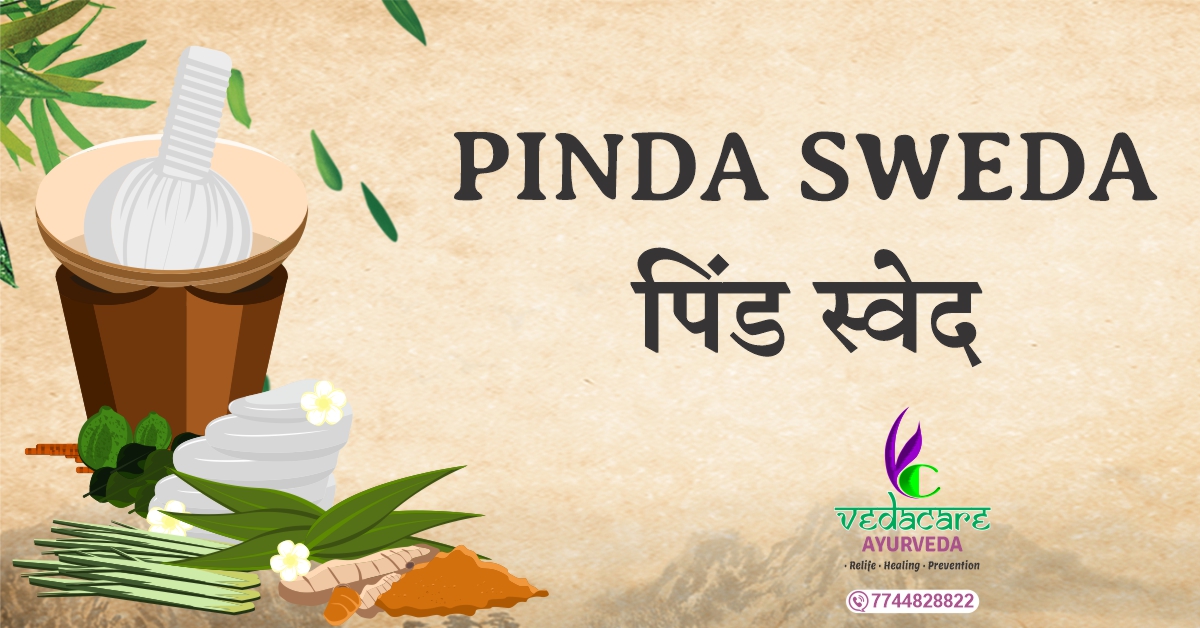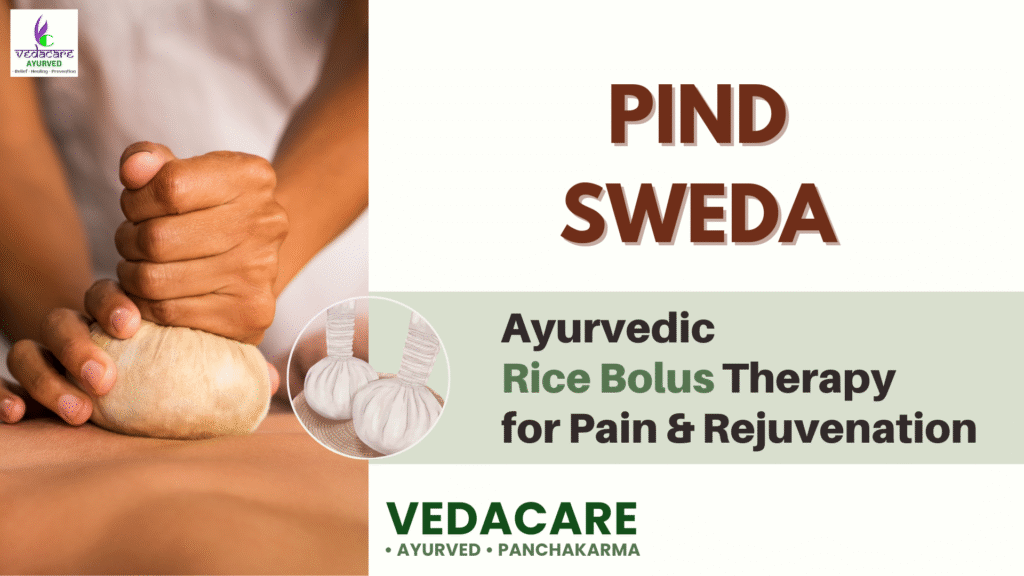PANCHAKARMA
Pind Sweda (पिंड स्वेद): Ayurveda’s Ultimate Pain Relief Therapy

Pind Sweda (Shashtika Shali Pinda Sweda) is one of the most effective and time-tested Ayurvedic Swedana (sudation) therapies frequently used for pain relief, nourishment, and rejuvenation of body tissues. In this procedure, therapeutic sweating is induced using a warm bolus (pinda) made from special medicated rice known as Shashtika Shali (a variety of rice harvested in 60 days).
This treatment is also referred to as Navarakizhi in Kerala Ayurveda. It is ideal for children, healthy individuals seeking rejuvenation (Rasayana), and patients with Vata disorders such as muscular weakness, joint pain, or neurological deficits.
शष्टीक शाली पिण्डः स्वेदयति वातं शमयति च || Shashtika shali pinda induces sweating and pacifies aggravated Vata
What is Shashtika Shali Pinda Sweda?
Shashtika Shali Pinda Sweda is an Ayurvedic sudation therapy that combines abhyanga (oil massage) with the application of warm rice bundles to induce sweating. Unlike Patra Pinda Sweda, which uses herbal leaves, this therapy employs Shashtika Shali rice cooked in a medicinal decoction and milk. The rice bundles are applied to the body, delivering heat and nourishment to tissues, relieving pain, and restoring vata balance. According to the Charaka Samhita, a foundational Ayurvedic text, sudation therapies like Pind Sweda are essential for managing vata disorders and promoting strength (Charaka Samhita, Sutrasthana, 14/39).
“Swedana is the procedure that alleviates stiffness, heaviness, and coldness, and induces sweating.” – Charaka Samhita
This therapy is suitable for healthy individuals, children, and those with vata-related ailments, making it a versatile treatment for both preventive and therapeutic purposes.
Key Features of Shashtika Shali Pinda Sweda
- Special Rice: Uses Shashtika Shali, known for its nourishing and strengthening properties.
- Targeted Application: Can be applied to the whole body below the neck or specific areas like the back or joints.
- Holistic Benefits: Balances vata dosha, reduces pain, and enhances tissue health.
Procedure of Shashtika Shali Pinda Sweda
The patient should undergo Deepana-Pachana (digestive fire kindling) if advised by the physician. The bowel and bladder should be evacuated.
The preparation and execution of Shashtika Shali Pinda Sweda are meticulous, ensuring maximum therapeutic benefits.
- Preparation of Rice: Shashtika Shali rice is boiled in a decoction of herbs (e.g., Bala or Ashwagandha) and milk, as prescribed by the Ayurvedic practitioner. This infuses the rice with medicinal properties.
- Forming Pinda: The cooked rice is divided and tied into multiple cotton cloth bundles (pinda), creating compact packs for application.
- Heating the Pinda: The rice bundles are warmed by dipping them in a mixture of warm decoction and milk, maintaining an optimal temperature.
- Abhyanga: The patient undergoes a full-body or localized oil massage (abhyanga) with medicated oils like Mahanarayan or Ksheerabala to prepare the body for sudation.
- Sudation: The warm rice bundles are gently massaged over the patient’s body, focusing on areas of pain or stiffness. The patient, minimally clothed, lies on an abhyanga table during the procedure.
- Timing: The therapy is ideally performed after the patient evacuates their bowel and bladder and before meals to ensure comfort and efficacy.
Post-Treatment Care for Shashtika Shali Pinda Sweda
Post-treatment care is crucial to consolidate the therapy’s benefits and prevent discomfort:
- Rest Period: Patients rest in a chair for approximately 15 minutes to stabilize the body after intense sudation.
- Hot Water Bath: A warm bath is recommended to refresh the body and alleviate residual tiredness. Harsh soaps should be avoided; instead, use Ayurvedic ubtan or Bengal gram flour to gently cleanse the skin and remove excess oil.
- Dietary Guidelines: Consume light, warm, liquid-based foods like khichdi, moong dal soup, or vegetable broth to support digestion and recovery. Avoid heavy, cold, or processed foods.
- Environmental Precautions: Rest in a room at normal temperature without fans or air conditioning for a short period. Avoid exposure to cold breezes, open air, or cold water immediately after therapy.
Duration and Frequency of Shashtika Shali Pinda Sweda
The duration and frequency of the therapy vary based on the individual’s health status and therapeutic goals:
- Standard Course: A typical course involves 7, 14, or 21 sessions, conducted daily or on alternate days. A 14-day course is ideal for promoting general health in healthy individuals.
- Maintenance: One to two courses per year are recommended for preventive care and overall wellness.
- Therapeutic Use: For chronic conditions like rheumatoid arthritis or disc prolapse, more frequent courses may be necessary, tailored to the severity of the condition and the patient’s response.
Regular sudation strengthens the body and mitigates vata disorders. – Sushruta Samhita, Chikitsasthana, 32/12
Benefits of Shashtika Shali Pinda Sweda
Shashtika Shali Pinda Sweda offers a wide range of therapeutic benefits, particularly for vata-related disorders. Key benefits include:
- Pain Relief: Alleviates joint pain, backache, and muscle stiffness in conditions like arthritis, sciatica, and spondylitis.
- Improved Mobility: Enhances joint flexibility and reduces stiffness, aiding conditions like ankylosing spondylitis and lumbar spondylosis.
- Tissue Strengthening: Promotes tissue mass gain and improves organ function, supporting recovery from degenerative disorders.
- Dosha Balance: Corrects vata imbalances through the nourishing properties of Shashtika Shali and abhyanga.
- Lightness of Body: Induces a sense of lightness and reduces heaviness caused by vata and kapha aggravation.
- Disease Regression: Slows the progression of chronic conditions like rheumatoid arthritis and disc prolapse.
This therapy is particularly beneficial for individuals seeking natural remedies for chronic pain, neurological issues, or mobility challenges.
Indications for Shashtika Shali Pinda Sweda
Shashtika Shali Pinda Sweda is indicated for a variety of conditions, particularly those involving vata aggravation. Common indications include:
- Vata Vyadhi (disorders caused by vata imbalance)
- Arthritis (rheumatoid and osteoarthritis)
- Gout
- Paralysis
- Chronic low backache
- Varicose veins
- Lumbar spondylosis
- Spondylolisthesis
- Disc prolapse
- Ankylosing spondylitis
- Sacroiliitis
- Lumbosacral strain
- Sciatica
- Lumbar spondylitis
- Slip disc
- Degeneration of vertebral disc
Monitoring and Follow-Up
The patient’s response to Shashtika Shali Pinda Sweda is closely monitored through periodic assessments and follow-up visits. The Ayurvedic practitioner evaluates improvements in pain, mobility, and overall health, adjusting the treatment plan as needed to ensure optimal outcomes.
Types of Pinda Sweda
| Type | Description | Best For | Key Ingredients |
|---|---|---|---|
| Shashtika Shali Pinda Sweda | Rice bolus in medicated milk and Bala decoction | Muscle wasting, paralysis | Shashtika Shali rice, Bala root, milk |
| Patra Pinda Sweda | Herbal leaf bolus | Joint pain, muscle spasm | Nirgundi, Eranda, Arka, Dashmoola |
| Choorna Pinda Sweda | Herbal powder bolus | Muscular stiffness, arthritis | Rasnadi, Nirgundi, Eranda, Haridra, Ajwain |
| Valuka Sweda | Sand bolus | Chronic |
Pind Sweda is one of Ayurveda’s most powerful rejuvenative and pain-relieving therapies. By combining ancient wisdom with modern therapeutic needs, it helps restore vitality, reduce chronic inflammation, and strengthen bodily tissues in a holistic manner.
Shashtika Shali Pinda Sweda is a powerful Ayurvedic therapy that offers natural relief from pain, stiffness, and vata-related disorders. By combining the nourishing properties of Shashtika Shali rice, medicated oils, and sudation, it promotes tissue strength, enhances mobility, and supports holistic wellness. With proper preparation, post-treatment care, and a supportive diet, this therapy can significantly improve quality of life. Consult a qualified Ayurvedic practitioner to determine if Shashtika Shali Pinda Sweda is right for you, and embrace the healing power of Ayurveda today.
“Ayurveda aims not just to cure, but to restore wholeness to body, mind, and spirit.”
1. What is Shashtika Shali Pinda Sweda in Ayurveda?
Shashtika Shali Pinda Sweda, or Navarakizhi, is an Ayurvedic sudation therapy using warm rice bundles made from Shashtika Shali to relieve pain, strengthen tissues, and balance vata dosha.
2. How long does a Shashtika Shali Pinda Sweda session last?
A single session typically lasts 45–60 minutes, depending on the condition. A full course may involve 7–21 sessions.
3. Is Shashtika Shali Pinda Sweda safe for everyone?
It is generally safe but should be performed under a qualified Ayurvedic practitioner’s guidance, especially for pregnant individuals or those with severe health conditions.
4. Can Shashtika Shali Pinda Sweda help with sciatica?
Yes, it is highly effective for sciatica, reducing pain, stiffness, and inflammation while improving mobility.
5. What should I eat after Shashtika Shali Pinda Sweda?
Consume light, warm, liquid-based foods like khichdi or vegetable soup. Avoid cold, heavy, or processed foods.
6. How often should I undergo Shashtika Shali Pinda Sweda?
For general wellness, 1–2 courses (7–14 sessions) per year are recommended. For chronic conditions, frequency depends on the practitioner’s advice.
7. Are there any side effects of Shashtika Shali Pinda Sweda?
Side effects are rare when performed correctly. Temporary tiredness or mild skin irritation may occur, resolving after rest and a warm bath.
8. What is the difference between Shashtika Shali Pinda Sweda and Patra Pinda Sweda?
Shashtika Shali Pinda Sweda uses Shashtika Shali rice, while Patra Pinda Sweda uses herbal leaves. Both are sudation therapies but differ in ingredients and specific applications.
9. How does Pind Sweda differ from Patra Pottali?
Pind Sweda uses rice boluses for deeper heat penetration (7 dhatus), while Patra Pottali uses herbs for localized inflammation.
10. Can it be used along with modern treatments?
Yes, it can be used as a complementary therapy to improve outcomes and reduce dependency on painkillers.
11. Is Pind Sweda safe for elderly patients?
Yes. It is gentle, deeply nourishing, and especially suitable for the elderly or those with chronic weakness.
12. Who can benefit from Shashtika Shali Pinda Swedan?
People suffering from joint pain, paralysis, muscle wasting, and neurological conditions can benefit from this therapy.
13. Ayurvedic therapy for paralysis recovery?
Shashtika Shali Pinda Sweda can benefit in paralysis recovery in People suffering from joint pain, muscle wasting, and neurological conditions.
14. Does Pind Sweda help in ankylosing spondylitis?
Yes
15. Natural way to strengthen joints in Ayurveda?
Shashtika Shali Pinda Sweda is best to strengthen joint
Along with pind svedan therapy Basti Panchakarma, Raktamokshan, Agnikarma, Patra Pinda Sweda, Lepan treatments are useful in fastening the disease recovery or relieving chronic pain.



